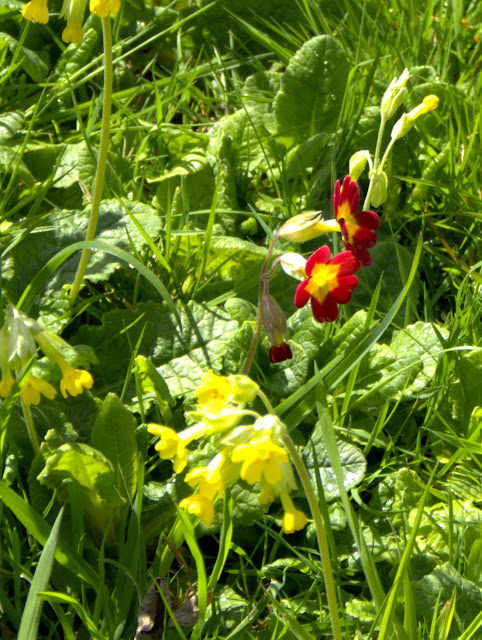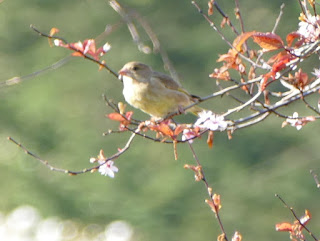From a single Cowslip plant, Primula veris, left to seed on a lawn, which is mown twice a year in Autumn and winter, for many years, there are now hundreds of cowslips in bloom.
Among them are some colourful hybrids, which may have come in as seed from neighbouring gardens or the result of a cross from pollen from gaudy garden Primulas. They are dug up to keep the cowslips from too much genetic contamination but as they are quite pretty, some are potted up for ornamental flower beds.
Above has to go.
This one has been left, just for fun. It is Primula x polyantha: a primrose/cowslip hybrid.
Time to stop the practice of chemical "feed & weed" now perhaps. Enjoy wild flowers and spent less time mowing.
For illustrated talks on natural history and history see www.peterlovetttalks.co.uk
For illustrated talks on natural history and history click here for www.peterlovetttalks.co.uk
Thursday, 28 April 2016
Wednesday, 27 April 2016
Oh I do like to be beside the seaside... with Early-purple orchids, stonechats and violets.
Early-purple orchids blooming in a bitterly cold wind yesterday on the chalk hills of East Sussex.
For details of an illustrated talk on native orchids, please click http://www.peterlovetttalks.co.uk/orchids.html
Click any picture to expand.
Male and female stonechats above and below.
Common Dog-violets.
For details of an illustrated talk on native orchids, please click http://www.peterlovetttalks.co.uk/orchids.html
Click any picture to expand.
Male and female stonechats above and below.
Common Dog-violets.
Sunday, 17 April 2016
Solitary bees: Hairy-footed Flower Bee, Anthophora plumipes & the cleptoparasitic Common Mourning Bee, Melecta albifrons in a Cuckfield garden this week in West Sussex, UK.
Above is the male Hairy-footed Flower Bee, Anthophora plumipes in my garden this week. Note its hairy feet against the rosemary flower. Click the photo' to expand it.
The female Hairy-footed Flower Bee, Anthophora plumipes above and below has orange-coloured legs.
This striking little black and white bee is feeding on Ground ivy -- a popular wild flower with many insects now. It creates a hole in a closed Anthophora nest cell and then oviposits an egg on the wall inside before sealing the hole. The first-instar larva then destroys the host egg or grub with its long, sickle-shaped mandibles and proceeds to eat the food store.
Source: Field Guide to the Bees of Great Britain and Ireland by Steven Falk.
The drama occurring in a wild flower patch is just amazing to observe.
For anyone responsible for finding public speakers, please see http://www.peterlovetttalks.co.uk/page15.html
The female Hairy-footed Flower Bee, Anthophora plumipes above and below has orange-coloured legs.
This female Hairy-footed Flower Bee's legs appear to be covered in yellow Cowslip pollen. Cowslips flourish in my unmown lawn, which is a profusion of yellow at present.
She will be making a nest somewhere to lay her eggs, which will be threatened by the Common Mourning Bee, Melecta albifrons below.
This striking little black and white bee is feeding on Ground ivy -- a popular wild flower with many insects now. It creates a hole in a closed Anthophora nest cell and then oviposits an egg on the wall inside before sealing the hole. The first-instar larva then destroys the host egg or grub with its long, sickle-shaped mandibles and proceeds to eat the food store.
Source: Field Guide to the Bees of Great Britain and Ireland by Steven Falk.
The drama occurring in a wild flower patch is just amazing to observe.
For anyone responsible for finding public speakers, please see http://www.peterlovetttalks.co.uk/page15.html
Wednesday, 13 April 2016
Median wasp queen in Cuckfield garden, West Sussex
The second largest British social wasp species. Dolichovespula media was first recorded in 1980 in Sussex, since when it has spread over all of England and Wales, and much of southern Scotland. It has a short life cycle, with nests finishing in August.
Nests are aerial and generally exposed, usually hanging from trees or bushes.
Source: http://www.bwars.com/content/beginners-bees-wasps-ants-dolichovespula-media Bees, Wasps & Ants Recording Society
Tuesday, 12 April 2016
White-tailed bumblebee queen on Fritillaria meleagris
What a joy to see this queen collecting pollen from these snake-head fritillaries in my garden this morning.
If you are looking for talks on natural history in Sussex, e.g. bees, please see my web site at http://www.peterlovetttalks.co.uk/page15.html
Monday, 11 April 2016
Sunday, 10 April 2016
Scathophaga stercoraria, commonly known as the yellow dung fly, Shabden Park, Surrey
Shabden Park was glorious this afternoon with newly born lambs and their mothers. And lots of dung means lots of yellow dung flies, Scathophaga stercoraria.
What fascinating flies these are: males with golden hairy legs and the much smaller highly promiscuous females mating on the romantic setting of a sheep dropping.
What fascinating flies these are: males with golden hairy legs and the much smaller highly promiscuous females mating on the romantic setting of a sheep dropping.
click to expand pictures
Above a mating pair.
Their life cycle is extraordinary and well explained on Wikipedia: see https://en.wikipedia.org/wiki/Scathophaga_stercoraria
Thursday, 7 April 2016
A nature walk in The Netherlands: Red-tailed bumblebee on Butterbur, Great tits, Willow tits and hundreds of Barnacle, Greylag and Egyptian geese.
The historic town of Gorinchem sits by a great river protected by a rampart and dykes. Above a Butterbur species was flowering on the bank last Friday, 1st April.
A red-tailed bumblebee queen was foraging. Click on any picture to enlarge it.
Some decades ago the bank and lock gates were raised a meter or so against high river levels.
On the meadows were an estimated thousand geese an this few miles walk along the riverside.
A red-tailed bumblebee queen was foraging. Click on any picture to enlarge it.
She was carrying a number of mites, which is a common phenomenon and apparently they are not feeding on her per se, rather hitching a lift to her new nest where they will live and feed.
On the meadows were an estimated thousand geese an this few miles walk along the riverside.
Barnacle geese above.
Greylag geese
Just one of scores of Great-crested grebe on the river.
A steam tug by the lock in Gorinchem.
Subscribe to:
Comments (Atom)
Blog Archive
-
▼
2016
(86)
-
▼
April
(10)
- Promiscuity in a Cuckfield wild-flower garden
- Oh I do like to be beside the seaside... with Earl...
- Solitary bees: Hairy-footed Flower Bee, Anthophora...
- Median wasp queen in Cuckfield garden, West Sussex
- A healthy breakfast of flowering plum flowers for ...
- White-tailed bumblebee queen on Fritillaria meleagris
- Male Tawny Minig Bee in a Sussex garden this after...
- Scathophaga stercoraria, commonly known as the yel...
- A nature walk in The Netherlands: Red-tailed bumbl...
- Enjoy the mauve colours in Sussex woods before the...
-
▼
April
(10)




















































